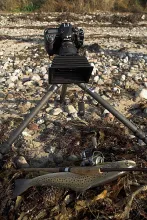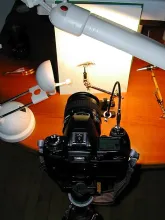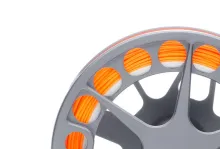If you want really sharp fishing images there's no avoiding some kind support for your camera. A steady tripod is the best solution and the one that you see pros using, but there are other ways of supporting your camera as GFF partner Martin Joergensen explains here.
If you're on the lookout for some really sharp images, you need to use a tripod. Of course you can get sharp images with a handheld camera, but it just requires extremely fast shutter speeds or the use of a flash. A good rule of thumb is that it requires about twice the focal length in fractions of a second to hold a camera still.
That means that a 50mm (film equivalent) lens requires 1/100th of a second to be steady and a 200mm roughly requires 1/500th. The factor also depends on the movement of the subject and on how steady your grip is. My own experience is that a factor around four is more like it and if you really want sharpness a shutter speed of 1/1000th or 1/2000th of a second is good. As your focal length grows - when you zoom in or change to a telephoto lens - this demand rises, and at really long focal lengths like 300-500 mm on a 35 mm film camera, there are only slim chances of holding the camera still. Now, most small cameras don't even reach these short shutter speeds and even if they did, the light required for such fast speeds is rarely there.
The solution to that is a tripod. And make that a steady one.
You rarely see amateurs use tripods. That is most likely because they don't want to carry one around. Pros, on the other hand, use them all the time. A steady tripod can make even a 1 second long exposure sharp. And for landscapes and other scenery pictures, there's no reason not to use one. Pictures taken at dusk or dawn also benefit from the stability of a tripod. The light is just barely bright enough to obtain short shutter speeds, and the tripod will help here.
For action pictures and people shots, it is more difficult to bring the camera in position if it's attached to a tripod. In those cases you will just have to rely on available light being bright enough or use your flash to freeze things.
I recommend choosing a sturdy tripod of professional build and quality. They are both more expensive and heavier than the amateur models, but they do the job so much better. Lightweight carbon fiber models are available if money is no issue... Get a good ball head to go withy that and you're set.
As an alternative to the heavy tripod you can use a small pocket tripod, which is no more than 30-40 centimeters or one foot high. It is not as stable as the big tripods, but certainly better than nothing.
A so-called beanbag is also a great option and can easily replace such a compact tripod. It's a soft cushion that you can put between a stable surface and your camera. It has the advantage of shaping itself to fit both base and camera.
You can of course just put your camera directly on a rock, on a branch or whatever is available, but stability is not always good, and finding a horizontal surface can be a problem.
When using any tripod or support, it's always advisable to use a delayed shutter release. Either utilize the self timer, which typically gives a 10 second delay, or use the 2 second delay that many modern cameras offer. This will keep you from rocking the camera when you press the shutter. Another common method of avoiding shake when pressing the shutter release is to take several pictures immediately after each other with the camera set to multiple frames. This usually isolates the shaking to the first frame, while the camera is steady in the rest of the series. There is a good chance that one of the images will be sharp.
Anti shake
Many modern digital cameras now have an anti shake option - either as a feature of the camera itself or in certain lenses. Anti shake will drastically reduce shake in some situations, and in the best cases earn you two or three aperture steps. But it will not replace a good tripod. Tack sharp images still call for extremely high shutter speeds, flash or a stable tripod.
I also have a small photography site called 500th.net you can visit.
- Log in to post comments



















